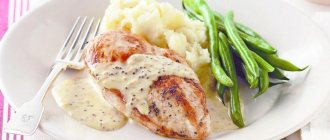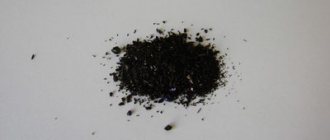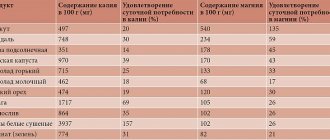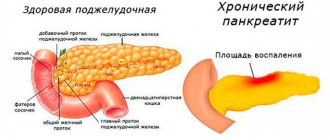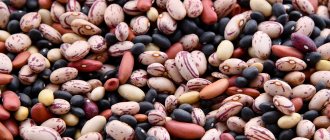Avocado
Avocados have become an extremely popular fruit lately—and for good reason.
These fruits are rich in healthy fats and are also a particularly important source of vitamin K and folic acid. One half of an avocado (100 g) contains 485 mg of potassium or 10% of the AUL. If you eat a whole avocado, you will get 20% of the AUP of potassium (,).
Moreover, avocados may help people with high blood pressure, who are often advised to increase their potassium intake and reduce their salt (sodium) intake.
This recommendation is based on a study called the Dietary Approach to Stop Hypertension (DASH). Further studies confirmed the benefits of potassium in lowering blood pressure (,).
Avocados, like most fruits, are low in sodium. Half an avocado contains 7 mg or just 0.5% of the recommended daily intake (RDI) of sodium ().
You can learn more about the beneficial properties of avocados here – 12 beneficial properties of avocados proven by science.
Conclusion:
Avocados are rich in nutrients—just half the fruit provides your body with 14% of the AUP of potassium. It is also rich in vitamin K and folic acid, and may even lower blood pressure levels.
Contraindications
Like all products, there are beneficial properties and contraindications. People suffering from the diseases listed below should not consume these fruits, because they irritate the intestines, thicken the blood, remove fluid and lead to weight gain:
- excess weight;
- ischemia;
- problems with blood clotting;
- irritable bowel syndrome;
- Due to the high sugar content, those with diabetes need to be careful.
Yam (sweet potato)
Like avocados, sweet potatoes are becoming increasingly popular and are often used as an alternative to potatoes.
Sweet potatoes are a high potassium food - one medium-sized sweet potato contains 541 mg of potassium, which is equal to 12% of the AUP (,).
Moreover, sweet potatoes are low in fat and low in protein, and are a good source of complex carbohydrates and fiber. They are also an excellent source of vitamin A, with one sweet potato providing more than 400% of the RDI ().
Combine this tasty root vegetable with high-quality protein sources such as legumes or meat, dark green leafy vegetables or colorful vegetables, and a little fat to create a well-balanced and satisfying meal.
Conclusion:
Eating yams (sweet potatoes) is a great way to add more potassium to your diet. Just one medium-sized root vegetable can supply your body with 12% of the AUP of potassium, as well as a small amount of protein, fiber and vitamin A.
Application
Bananas in medicine
For its properties, the product is used in the treatment of certain diseases.
- For diabetes mellitus, it is recommended to eat green fruits or yellow ones, but boiled. If you lack sugar, you can eat ripe fruit, which has a glycemic index of 50 units.
- Banana is beneficial for pancreatitis, because. envelops the walls of the stomach and regulates gastrointestinal processes.
- In the treatment of gastritis, thanks to the properties of bananas, inflammatory processes are reduced.
- If you have problems with the intestines, they are also recommended for use, because they promote bowel movement.
- Regular use helps with constipation, because... Helps soften bowel movements.
- In case of gout, they influence inflammatory processes and relieve pain.
- During an exacerbation of colitis, bananas are added to the diet, for example, small ones promise as much benefit as large ones.
- Fruits remove waste and toxins, and therefore are incredibly healing for the liver.
- Unpleasant sensations during exacerbation of hemorrhoids constantly haunt the patient; if fruits are added to the diet, then problems in the functioning of the stomach and intestines will be eliminated and the exacerbation will pass more calmly.
- Even with cholecystitis, you can eat berries, but this should be done carefully and in small quantities.
Bananas in cosmetology
Banana essential oil also has medicinal properties , which is used as an additional ingredient in face cream. It provides vitamins, perfectly softens the skin, eliminates dryness, flaking and dandruff, and reduces scalp oiliness. In addition, it is used to lubricate dry elbows and rough skin on the heels; it softens the skin and makes it tender and soft. The oil also eliminates nail brittleness, strengthening the plate and making it dense and uniform.
Essential little banana. Photo: sc01.alicdn.com
Folk remedies with banana
- Hair mask from 1 tbsp. l. honey and lemon juice, as well as crushed banana, applied to the hair roots for several hours, will saturate with vitamins, strengthen the hair follicles and reduce oiliness.
- You can make a face mask from a banana; it will be especially useful for those who have very dry skin. To do this you need to take 2 tsp. fat cottage cheese, 1 tsp. pulp, yolk and 1 tsp. camphor oil, mix until smooth and apply to skin for 30 minutes, then rinse with warm water. As a result, the skin will become soft, become fresh, nourished, fine wrinkles will be smoothed out, and dryness will disappear.
- There is a folk recipe with a banana for coughs; for this you can mix half a teaspoon of honey, a glass of boiling water and crushed fruit, let it brew and drink half a glass warm every 2 hours. Children can prepare another recipe - crushed fruit, 2 tsp. cocoa, honey and a glass of hot milk, mix and drink hot in small sips.
Bananas in cooking
The product is actively added to smoothies, cocktails, fillings are made for pancakes and muffins are baked with them, in addition, they are prepared as an independent dish, for example, fried or baked.
This is interesting! To wake up in the morning, you can take a ripe banana, a glass of coffee and a glass of milk, mix in a blender, and a drink full of benefits is ready to drink.
Spinach
Without a doubt, spinach is one of the most nutrient-rich vegetables.
156 grams of frozen spinach contains 540 mg of potassium, which is equal to 12% of the AUP (,).
It also contains a number of other nutrients. The same amount of spinach contains 366% of the RDA for vitamin A, 725% of vitamin K, 57% of folic acid and 29% of magnesium ().
Likewise, 100 grams of raw spinach contains 558 mg of potassium, which is 12% of the AUP ().
Keep in mind that visually, 100 grams of raw spinach looks much larger on your plate than the same amount of frozen spinach.
Conclusion:
Spinach contains more potassium than a banana - 12% of the AVP per 156 gram serving of frozen spinach or 100 grams of raw spinach. This vegetable also contains vitamins A and K, as well as folic acid and magnesium.
The role of potassium in the body
Potassium is contained in cells, ensuring the transmission of nerve impulses, and plays an important role in the distribution of fluid and normalization of water balance in the body (read more in the article about potassium).
Potassium, in close interaction with sodium, regulates cellular processes and performs the following functions:
- maintains a normal acid-alkali ratio in the body;
- regulates the water level in tissues;
- forms energy balance;
- controls the contraction of the heart muscles;
- normalizes blood pressure;
- improves kidney function;
- stimulates insulin production;
- prevents the leaching of calcium from bones;
- relieves muscle spasms.
Potassium increases blood circulation in the brain, which helps improve concentration and memory. With a sufficient amount of the substance, the body is able to deal with stress more effectively.
Watermelon
Watermelon is a large, tasty fruit with a high water content.
Just two slices of watermelon (about 1/8 of a watermelon or 572 grams) will give you 640 mg of potassium, which equates to about 14% of the AUP (,).
The same serving size also contains 172 calories, 44 g carbohydrates, 3.4 g protein, 0.8 g fat and 2.2 g fiber ().
Moreover, watermelon is an excellent source of vitamins A and C, as well as magnesium.
Conclusion:
Watermelon is a delicious summer fruit, just two cups of which can provide your body with almost 14% of the potassium content, as well as vitamins A and C, and only 172 calories.
Coconut water
Coconut water is a fantastic drink.
It is an excellent natural alternative to sports drinks as it contains key electrolytes that help hydrate your cells, and its natural sugars provide energy during exercise or replenish glycogen stores afterwards ().
One cup (240 ml) of coconut water contains 600 mg or about 13% of the AUP of potassium. In addition, it is a good source of magnesium, calcium, sodium and manganese (,).
It is refreshing when served cold after a tiring workout.
Conclusion:
Coconut water is not only an excellent hydrating drink, but also an excellent source of potassium, containing 13% of the AUP in just one cup (240 ml). It is also a good source of magnesium, calcium, sodium and manganese.
White beans
The term "white bean" can refer to white Navy beans, great northern beans, or moon beans.
Although bananas are lauded for their high potassium content, one 179-gram serving of any white bean contains twice as much potassium as one banana. One serving of white beans provides your body with 829 mg of potassium, which is equal to 18% of the AUL (, ,).
One such serving also provides 28-61% of the RDA for various B vitamins. In addition, white beans are an excellent source of iron and plant protein ().
Since one serving (179 grams) contains almost 19 grams of fiber, it also contributes significantly to the feeling of fullness in the stomach ().
White beans are incredibly versatile and can be easily added to your diet, such as as an ingredient in salads, soups, or stews.
Conclusion:
White beans are an amazing source of potassium. One 179 gram serving contains 18% of the AUP of potassium, which is equivalent to two bananas. These beans can easily be added to salads, soups and stews, making it easier to increase your potassium intake.
Carbohydrates
Bananas are a rich source of carbohydrates. Unripe bananas contain mainly starch, while ripe ones contain sugar. The carbohydrate composition of bananas changes dramatically during ripening.
The main component of unripe bananas is starch - green bananas contain up to 70-80% starch, in dry weight.
During ripening, starch is converted to sugars and makes up less than 1% when the banana is fully ripe. The most common types of sugar found in ripe bananas are sucrose, fructose and glucose. In ripe bananas, the total sugar content can reach more than 16% by weight of the fresh fruit (2).
Depending on the degree of ripeness, bananas have a relatively low glycemic index of 42-58 (3). This is a measure of how quickly carbohydrates in food enter the bloodstream.
Bananas' low glycemic index is due to their high resistant starch and fiber content, which prevent blood sugar levels from rising quickly after eating.
Black beans
Black beans, also known as Preto black beans, are a staple food in Central and South America.
It is often used in burritos and soups.
Although white beans may contain more potassium than black beans, the latter are still an excellent source of potassium. One 172 gram serving of black beans contains 611 mg of potassium, which is equal to 13% of the AUL (,).
However, because black beans contain phytates, which can reduce your body's absorption of minerals, not all of that potassium can be used.
It's hard to know how much these phytates might affect the absorption of minerals like potassium, but if you're using dried beans, it's best to soak them in water overnight before cooking. This action will help reduce the amount of phytates ().
Conclusion:
Black beans are a versatile food that can provide your body with 13% of the AUL of potassium per 172 gram serving. Long soaking of dried beans can improve the absorption of minerals, including potassium.
Edamame
Traditionally consumed in Japan, edamame is boiled, unripe soybeans served in a pod.
This popular Japanese snack also contains more potassium per serving than a banana. In fact, one serving (155 grams) provides the body with 676 mg or just over 14% of the potassium of the AUP (,).
Edamame is rich in many other nutrients, but mainly contains 121% of the RDA for folate per serving (155 grams) ().
What's more, this snack is an excellent source of vitamin K, magnesium and manganese ().
Unripe soybeans are delicious lightly steamed when used as an accompaniment to main dishes.
Conclusion:
Edamame is rich in nutrients - one 155 gram serving provides the body with 14% of the AUP of potassium, as well as good amounts of vitamin K, magnesium and manganese.
Tomato paste
Tomato paste is made from cooked tomatoes that have been peeled and seeded.
This concentrated seasoning improves the taste of tomato sauces and dishes.
Just three tablespoons of tomato paste (about 50 grams) contains 486 mg of potassium, which is just over 10% of the AUL. Tomato paste is also a good source of vitamin C and lycopene, a beneficial plant compound (,).
Try to use only tomato pastes without added sugar, additives or preservatives. It is advisable to choose a product with the fewest ingredients.
Conclusion:
Tomato paste not only enriches the taste of your food, but also provides the body with sufficient potassium. Just three tablespoons (about 50 grams) of tomato paste contains about 10% of the AUP of potassium, as well as vitamin C and the beneficial plant compound lycopene.
Butternut squash
Butternut squash is a sweet-tasting winter squash.
One 205 gram serving of butternut squash contains 582 mg of potassium - more than 12% of the AUL (,).
It is also an excellent source of vitamins A and C and contains smaller amounts of B vitamins, vitamin E and magnesium ().
Butternut squash can be roasted, boiled, steamed, or chopped for use in soups.
Conclusion:
Butternut squash is an excellent source of potassium, providing 12% of the AUL in one 205 gram serving. This fruit also contains vitamins A and C, as well as smaller amounts of B vitamins, vitamin E and magnesium.
Potato
Potatoes are a starchy root vegetable that is a staple food in several countries around the world.
One whole potato (136 grams) can provide the body with 515 mg of potassium, which is 11% of the AUL (,).
In fact, one study reported that potatoes are the best dietary source of potassium, with a small baked potato containing 738 mg of potassium, or nearly 16% of the AUL (, ).
However, there are many different varieties of potatoes, and their potassium levels may depend on the soil in which they are grown.
Because potatoes are consumed daily in many parts of the world, they may be a key food source for providing large quantities of potassium.
Read more about the benefits of potatoes here - Benefits of potatoes: nutritional value and medicinal properties.
Conclusion:
Potatoes are a staple in many households, and they are one of the richest foods in potassium. One potato usually provides a person with 11% of the AUP of potassium.
Daily potassium requirement
Maintaining normal levels of the mineral in the body is the key to well-being and good health.
The daily value of potassium depends on age and is:
- children: infants up to 6 months - 400 mg;
- from 7 months to 1 year - 700 mg;
- from 1 year to 3 years - 3,000 mg;
- from 4 to 8 years - 3,800 mg;
- from 9 to 13 years - 4,500 mg;
- from 14 to 18 years - 4,700 mg;
During breastfeeding, the need for the substance increases and is at least 5,100 mg per day. Athletes, diabetics and those on a low-carbohydrate diet also need higher levels of potassium.
Dried apricots
Dried apricots are dried apricots. This dried fruit has a long shelf life and, as a rule, does not have a seed.
Six dried apricots provide the body with 488 mg of potassium, which is more than 10% of the AUL. These dried fruits are also a good source of fiber and vitamins A and E (,).
Dried apricots mix well with granola and make a healthy snack for camping or traveling.
Read more about the health benefits of dried apricots here - Dried apricots: benefits and harm to the body, how much to eat.
Conclusion:
Dried apricots (dried apricots) are a great alternative to bananas to boost your potassium levels. About six dried apricots will give you 10% of the AUP of potassium, as well as fiber and vitamins A and E.
Chard
Swiss chard, or simply chard, is a leafy green vegetable.
Its thick stems can range in color from red and orange to white.
This vegetable is very nutritious. Just one 178-gram serving of cooked chard provides 961 mg, or 20% of the AUP, of potassium—more than twice the amount of potassium found in a banana (,).
The same amount also contains 716% of the RDA for vitamin K and 214% of the RDA for vitamin A ().
It is also low in calories and high in fiber.
Swiss chard is sometimes overlooked in favor of other leafy greens, but it makes a tasty salad base and can be easily steamed or sautéed with a little oil.
Conclusion:
Swiss chard is a nutritious dark green vegetable that contains twice as much potassium per serving as a banana—about 20% of the AUL. It is also rich in vitamins K and A.
Beet
Beets are a dark purple vegetable that is often boiled, pickled, or added to salads.
One 170 gram serving of cooked beets can provide your body with 518 mg of potassium, or 11% of the AUL (,).
For those looking to increase their potassium intake to prevent or reduce high blood pressure, beets may have an added benefit.
This root vegetable also contains nitrates, which, when converted into nitric oxide, have been shown to support blood vessel function and overall heart health ().
Beets are also an excellent source of folic acid - one 170 gram serving contains 34% of the RDI ().
Read more about the beneficial properties of beets here - Beetroot: benefits and harm to the body, how much to eat.
Conclusion:
Beets are a dark purple vegetable that, when cooked, contains 11% of the AUP of potassium in one 170 gram serving. They are also a good source of folate and contain nitrates, which have been shown to support heart health.
Beneficial properties of banana
Composition and calorie content
Fresh banana contains (per 100g): [7]
Calories 89 Kcal
- Proteins
1.09g - Fat
0.33g - Carbohydrates
22.84g - Water
74.91g - Ash
0.82g
| Vitamins | mg | Minerals | mg |
| Vitamin B4 | 9,8 | Potassium, K | 358 |
| Vitamin C | 8,7 | Magnesium, Mg | 27 |
| Vitamin B3 | 0,665 | Phosphorus, P | 22 |
| Vitamin B5 | 0,334 | Calcium, Ca | 5 |
| Vitamin B6 | 0,367 | Sodium, Na | 1 |
Full composition
So, fresh banana is not very fatty, but very nutritious and energetically valuable product. As for plantains, which require heat treatment before consumption, they are rich in the same minerals and vitamins as dessert bananas. Baking such fruits preserves their beneficial substances, but frying reduces the amount of vitamins and makes them fatter and higher in calories.
Medicinal properties
Despite the fact that a banana consists of 75% water, it contains many useful components. For example, this tropical fruit is very rich in potassium, and thereby helps the body maintain heart and kidney health, and also enhances attention and activates brain function. Scientists claim that a sufficient amount of this mineral in the body prevents the formation of kidney stones, helps normalize blood pressure and reduces the risk of a heart attack by 27%[11]. Magnesium in combination with vitamins C and B6 also has a positive effect on heart function.
In addition, banana is recommended for diarrhea. The fruit itself will not solve the situation, but it will definitely help restore the level of potassium that is washed out of the body during an upset stomach [12]. Bananas also contain dietary fiber, which supports normal bowel function and plays an important role in preventing colorectal cancer. By the way, the antioxidants in bananas can help reduce damage from free radicals, which scientists believe contribute to the development of cancer.
Banana is considered an effective aid in the fight against ulcers because it contains substances that resist the bacteria that cause this disease. It also has an antacid effect (reduces irritation of the mucous membrane, soothes the digestive system) and coats the walls of the stomach.
Bananas are beneficial at any age, but are especially important at the earliest stage of life. So, puree from this tropical fruit usually becomes almost the baby’s first food after mother’s milk. As a rule, bananas do not cause allergies and provide the child’s body with useful substances. Moreover, according to the observations of British scientists, if children eat one banana every day, their risk of developing asthma is reduced by 34%[12].
Eating this tropical fruit also benefits your vision. Despite the fact that carrots are usually associated with a positive effect on the eyes, bananas also contribute to the fight against macular degeneration (damage to the retina and impairment of central vision), thanks to the presence of vitamin A.
Calcium is not found in very large quantities in bananas, but it still helps strengthen bones. In addition, certain indigestible carbohydrates increase the body's ability to absorb calcium from other sources.
Finally, bananas are often, and for good reason, associated with a product for athletes. Minerals and fast carbohydrates saturate the body and charge you with energy and strength for an intense workout. In addition, some scientists believe that bananas help reduce muscle cramps and relieve soreness. However, such an effect has not been scientifically proven.
Likewise, the effect of bananas on a person’s mood has not been proven. The antioxidant dopamine, obtained from bananas, does not affect hormonal levels, so you should not associate its entry into the body with an improvement in mood. And in the case of the amino acid tryptophan, which in the body is transformed into the neurotransmitter serotonin (“the good mood hormone”), its amount in a banana is so small that it can hardly affect the mood.
In medicine
Although bananas are not used in the pharmaceutical industry, they undoubtedly have medicinal properties that are actively used in folk medicine. In tropical countries, where the banana is considered one of the main components of the daily diet, not only the fruit pulp, but also the rest of the plant (roots, leaves, flowers, fruit peel) are used to treat various diseases. For example, it is believed that an infusion of flowers helps with diabetes, ulcers and bronchitis, the roots help with stomach disorders and dysentery, and the leaves help with skin wounds and burns[13]. In our area, the use of banana for medicinal purposes is mainly limited to the use of the fruit and its peel.
Drinks and infusions
For bronchitis, in combination with drug treatment, it is recommended to drink a honey-banana drink. To prepare it, peel and mash 3 ripe bananas, pour 400 ml of boiling water over them, and let the mixture brew for about 30 minutes. Add 2 tablespoons of honey to the cooled mixture and drink half a glass 4 times a day for 5 days.
A chocolate banana drink can help relieve a sore throat. You need to mash 1 ripe banana and add 1 tablespoon of cocoa powder to it. Then dissolve the resulting mixture in 1 glass of boiled milk. Take the product before bed for 5 days.
To combat a dry cough, it is recommended to mash one ripe banana, add 100 ml of orange juice, 200 ml of boiling water, 1 tablespoon of honey and cinnamon to taste. Use the product for 5-7 days. And if you brew a whole banana with the peel as tea, adding a little cinnamon, you will get a cure for insomnia.
Traditional healers claim that 1 mashed banana, poured into a glass of milk, can help the body cope with mild allergic reactions. The drink should be consumed 2-3 times a day. And if you add a little honey to this mixture, you will get a good hangover cure.
Finally, banana kvass is considered to help the body with arrhythmia. To prepare it, place 2 cups of chopped banana peels in cheesecloth and pour in 3 liters of boiled water. Then add 1 tablespoon of sour cream, a glass of sugar and leave for 12 days. A thin layer of mold may form on the surface of the liquid, which must be removed immediately. After 12 days, 1 liter of kvass can be poured and strained through cheesecloth, and to the remaining one add 1 liter of water and a third of a glass of sugar, leaving to steep for a few more days. You should drink half a glass of kvass 2 times a day before meals.
Applications
Banana peel, or less often banana pulp, is used as applications. The inside of the skin acts as a natural antiseptic, and thanks to tannins and wax, it can help stop bleeding. In addition, the oils in its composition help relieve pain and itching. Thus, you can apply the peel or pulp, carefully scraped from it with a knife, to scratches, abrasions, calluses, bruises, burns, and insect bites. Folk recipes also suggest regularly applying banana peels to warts. The result should be noticeable within 3-4 weeks.
In oriental medicine
In Eastern practice, banana is considered a healthy product and is used for various purposes. Particular attention is paid to the ripeness of the fruit, because this greatly affects its medicinal properties. For example, with ripening, a protein appears in a banana, which takes part in preventing the development of cancerous tumors. Conversely, an unripe banana contains resistant starch (dietary fiber), which, according to Indian doctors, improves diabetes.
Eastern medicine also considers banana an effective means of clearing blood vessels. This fruit contains phytosterols that help lower cholesterol levels. According to one recipe, you should pour 50 g of mashed banana into a cup of tea and add 2 teaspoons of honey. This remedy should be drunk morning and evening.
In addition, in Eastern practice it is not customary to combine banana with milk, as is often done in the West. It is believed that such a compound negatively affects the digestion process, can provoke allergies, and can also cause, seemingly completely unrelated, cough and runny nose[14].
In scientific research
Since the banana has many beneficial properties and forms a major part of the diet in many tropical countries, it has long been the subject of scientific research. Scientists are looking for ways to make this fruit more resistant to various diseases, and are also studying its potential as a medicinal product.
For example, a 10-year humanitarian project of a group of Australian researchers was recently successfully completed, the goal of which was to develop bananas rich in provitamin A. This task was set for scientists due to the fact that in Uganda and a number of other African countries hundreds of thousands of children die or become blind due to a lack of this vitamin in the body. Now the problem can be partly solved, thanks to future harvests of “golden” bananas[15]. In parallel, the mechanisms of carotenoid production in bananas are being studied in the USA[16].
Also in the United States, there is a group of scientists from different countries who are studying a compound found in bananas - the protein lectin (BanLec). It was discovered that this protein can become the basis for drugs against viral diseases (influenza, hepatitis C, HIV, etc.). The first experiments showed that it does not allow viruses to penetrate the body's cells, but at the same time causes side effects in the form of irritation and inflammation. Slightly “improved” by scientists, BanLec will gradually be tested on animals, and then on humans[17].
In addition, British scientists are working on creating medicines that will use fiber from bananas and broccoli. This drug is aimed at treating patients with Crohn's disease (an inflammatory disease of the gastrointestinal tract)[18].
In dietetics
Nutritionists recommend banana for inflammatory diseases of the mucous membranes of the duodenum, stomach and oral cavity. It is included in the diet for diseases of the pancreas, as well as some diseases of the liver and kidneys.
As for diets aimed at weight loss, the attitude towards bananas in this area is ambiguous. Some believe that this fruit is too high in calories and should under no circumstances be included in the diet of a person losing weight. Others, on the contrary, argue that bananas, although high in calories, do not contain fat, so they can and should be consumed, but in moderation.
In any case, during a diet it is preferable to eat unripe bananas, which contain starch that has not yet had time to turn into sugar. The glycemic index of such a fruit is only 30 units, while that of a ripe banana is about 50. Thus, the unripe fruit will take longer to digest, will avoid a sharp jump in sugar and will bring longer-lasting saturation.
In cooking
In some tropical countries, where banana is the basis of the diet, it is consumed not only raw or in desserts, but also boiled, deep-fried, and baked over coals. Plantains are usually used to make side dishes. Africans add them to porridges, omelettes, and even soups, and in China bananas can be found in vegetable salads. Sauces, casseroles, chips are made from bananas, flour and ketchup are made from them.
By the way, banana can also come in handy when cooking meat. In order to make it softer and more tender, experienced housewives add banana skins to the pan.
As for the compatibility of banana with other products, it goes well with sweet fruits and nuts. Some nutritionists do not see anything seditious in mixing bananas with dairy products, while others consider such a tandem unacceptable. It is best to eat a banana between meals, separately from other foods.
Beverages
Bananas are used to make a wide variety of drinks, from fresh juices, smoothies and cocktails to tea, coffee, beer and gin. More traditional for us, juices and smoothies, are recommended to be drunk every day between meals or after physical activity. Victoria's Secret nutritionists and trainers advise preparing green juice from a banana, two pears, a stalk of celery, a handful of spinach, lemon and honey.
Coffee lovers can not limit themselves to adding banana syrup to their drink, but also experiment with fresh fruit. So, you need to cool 350 ml of strong coffee, add 100 g of ice cream, 1 banana, a pinch of cinnamon, a little grated chocolate and beat everything in a blender. Then put crushed ice in a glass and pour the drink.
Bananas are also used in alcoholic drinks. For example, in Uganda it is used to make the national drink waragi (homemade gin). Waragi is usually drunk from barrels through special long straws.
Bananas can also be used to make a sweet wine-based cocktail. To do this, take 1 banana, 2 limes, 100 g of chocolate ice cream, 1 tablespoon of powdered sugar for a glass of white Muscat wine and add ice after mixing.
In cosmetology
Numerous studies show that banana is beneficial not only for the health of internal organs and systems, but is also effective when used externally. This fruit is actively used in the development of cosmetics for facial skin and hair care. Global cosmetic giants annually purchase tons of bananas to make various creams, masks, lotions, etc.
Banana is believed to help moisturize the skin, help eliminate wrinkles and contribute to the fight against acne. The recipe for a moisturizing mask is simple: mix half a ripe mashed banana with 1 tablespoon of yogurt and 1 tablespoon of vitamin E oil. Apply to a clean face and rinse off after 30 minutes. In order to make the skin more elastic and elastic, you should mix the pulp cut from a banana skin and one yolk. Keep this mask for 5 minutes and then wash off. To treat acne, simply rub the affected area with the inside of the peel and rinse with water after a few minutes.
In hair care, banana has a nourishing, moisturizing and strengthening effect. To achieve the effect and to avoid difficulties, you must adhere to the following recommendations:
- do not mash the banana with a fork, but beat with a blender until smooth, otherwise the lumps will not be washed out well;
- Before washing off the mask with water, you should apply shampoo to your hair and lather it, otherwise your hair may remain sticky;
- Do not keep the mask on your hair for longer than 20-30 minutes (do not let it dry).
As for recipes, to prepare a nutritious mixture you just need to beat a raw egg with 4 tablespoons of mashed banana. To achieve a moisturizing effect, you need to mix 3 tablespoons of banana and avocado puree, a raw egg and 2 tablespoons of unrefined olive oil. In the fight against hair loss, it is recommended to combine 4 tablespoons of banana puree with 1 tablespoon of sea salt, and add a little olive oil to obtain a thinner consistency. This mask is rubbed into the roots without applying to the entire length of the hair.
Non-traditional uses
The banana fruit itself is usually used quite traditionally, although sometimes banana skins are used instead of leather shoe polish or as a cosmetic product, but banana leaves have a much wider range of uses.
Firstly, they are used as decoration during various Buddhist ceremonies and rituals. They are also used as plates for traditional dishes in India. Secondly, banana leaves are used to make unique umbrellas, as well as a kind of packaging paper for food. Thirdly, even a special type of plant is grown - textile banana. Its strong false trunk made from leaves is used to make fishing nets, sea ropes and rafts. Finally, in some regions of India, banana leaves are still used instead of toilet paper.
Dangerous properties of banana and contraindications
Like any other food product, with a general positive effect on the body, in some situations, a banana can have the opposite effect. This does not mean that it must be completely excluded from the diet, but under certain conditions the consumption of this fruit should be limited.
- Banana actively removes fluid from the body, resulting in thickening of the blood and a decrease in its flow to organs and parts of the body. Therefore, people suffering from varicose veins, men who have problems with erections, and patients with thrombophlebitis should not get carried away with eating bananas.
- Taking beta blockers for cardiac diseases significantly increases the level of potassium in the body, so you should not eat large amounts of bananas rich in this mineral, especially if your kidneys are unhealthy.
- Bananas in large quantities are not recommended for irritable bowel syndrome as they can cause bloating.
- Uncontrolled consumption of bananas is contraindicated for obese people.
- People with diabetes need to be careful when choosing bananas. It is best to eat slightly unripe fruits, because when ripened, the complex carbohydrates they contain (starch and fiber) are transformed into carbohydrates with a high glycemic index.
We have collected the most important points about the benefits and possible harm of bananas in this illustration and will be very grateful if you share the picture on social networks with a link to our page:
Interesting Facts
The territories where bananas grow are located in one climatic zone that encircles the entire globe, and is humorously called the “banana belt.” In many of these countries, the banana is not inferior in importance to our bread, but Uganda and Burundi are considered the leaders in the consumption of this fruit, where, according to statistics, each person eats about 200 kg per year.
But in the Philippines they not only eat bananas, but also make good money from them. The Gokusen variety was bred by taking the best of 100 other varieties, so this fruit is more aromatic and sweeter than others. It is grown at an altitude of 500 m above sea level on ecologically clean land. One fruit weighs about 200 g and costs $6.
Naturally, having grown and consumed bananas for thousands of years, residents of tropical countries could not help but introduce the image of this fruit into their culture and language. For example, if in our country, when everything is going well, they say “like clockwork,” then in India they will say “it’s going like clockwork.” There are also many African proverbs in which, for example, a banana or its leaves are compared to a person: “an old banana leaf was once young and green” or “a woman who has given birth to a child is like a banana tree that has broken under the weight of its fruits.” .
If in tropical countries the banana has long been treated favorably, the same cannot be said about Europe. For example, in Germany in the 30s. In the 20th century, the exotic fruit was labeled “unpatriotic.” The thing is that the money used to import bananas was used for other needs. To hide this, doctors throughout the country were forced, following orders, to talk about the terrible dangers of the banana. And on the fruit stands there were posters: “Patriots eat German apples.”
Nowadays, bananas are actively sold all over the world, and marketers are never tired of coming up with new ways to increase sales. So, in one of the US supermarkets you can buy overripe bananas with the accompanying banana bread recipe. And in Korea they came up with a package containing seven bananas of varying degrees of ripeness (from still green to ready to eat today). The idea is that the fruits ripen gradually and, by purchasing such a set, the client receives a ripe banana every day.
The banana is also reflected in world culture. Monuments are dedicated to it (in the USA, Australia, Canada, Norway), museums are opened (in Australia, the USA, Germany), and on April 10 people celebrate a day dedicated to this fruit. In addition, songs were sung about bananas (for example, “We have no bananas” by Louis Prim or “Green bananas” by Jake Owen), children’s poems were written about them, and they were often depicted in still lifes. And recently, artists like the Dutchman Stefan Brusche have appeared, who turn banana fruits into real works of art.
Botanical description
Banana is the fruit of a large perennial herbaceous plant of the genus banana (lat. musa) of the banana family (lat. musaceae). Although in everyday life and in cooking we are accustomed to consider bananas as just fruits, botanists classify them as berries. It is these non-standard berries that are included in the world's top most important agricultural crops along with wheat, rice, corn and potatoes. According to statistics, people around the world eat about one hundred billion bananas every year [1].
origin of name
As for the scientific term Musa, there are two versions of its origin. According to the first, it was borrowed from Arabic, in which the word mauz (Arabic: موز) means banana. According to the second version, the Latin name was given in honor of the Greek botanist of the Renaissance, Antonio Muse. As for the word “banana” itself, it sounds the same in most modern European languages. It was probably originally adopted by the Portuguese or Spaniards from the West African Wolof language, in which it is pronounced banana [2].
Story
Numerous researchers of the origin of the banana agree that the birthplace of this fruit was the Malay Archipelago and Oceania. Scientists believe that people began growing bananas there for food in the 5th millennium BC. And some even claim that the banana was cultivated in Papua New Guinea (Oceania) back in the 8th millennium BC. [3]
Disputes about the period of appearance of bananas in Africa are still ongoing. Thus, some researchers are convinced that bananas have been grown in Madagascar for about 3 thousand years. However, more significant evidence suggests that these fruits appeared on the African island only in 400-600 AD, thanks to Asian colonizers. Around the same time, bananas spread throughout the Middle East, and in China they appeared a little earlier - around 200 AD, although they managed to gain widespread popularity only in the 20th century [4].
Thanks to Portuguese sailors who discovered yellow sweet fruits in Africa, banana plantations appeared on the Canary Islands, and from there the road opened for these fruits to the countries of the Caribbean, Central and South America. As for the North American continent, yellow fruits entered the diet of local residents only in the second half of the 19th century.
The same fate befell the banana in Europe. Before the beginning of the Victorian era, bananas were not in great demand, although they were already known in the Old World (according to legend, their great taste overwhelmed Alexander the Great, who brought them from India). A new wave of interest in bananas arose in the 19th century in Hamburg, Germany, where this overseas fruit was brought by sailors, and spread throughout Europe. The French especially liked the new delicacy. Moreover, in Paris, the banana became an integral symbol of salon life.
As for Russia, active import of bananas began under Nikita Khrushchev. Naturally, there is no need to talk about the widespread availability of these fruits, but in big cities they appeared on the shelves from time to time. However, in the 60s. relations between the USSR and one of the two main suppliers of tropical fruit, China, deteriorated. And another supplying country, Vietnam, was engulfed in war, so banana imports virtually ceased. In the 70s Leonid Brezhnev established the import of fruit from Africa and Latin America.
It is interesting that, unlike our time, when a yellow sweet banana can be purchased almost anywhere on the planet, previously it was not possible to enjoy the sweet variety of this tropical fruit everywhere. Not in all countries where bananas grew, they were suitable for eating raw. And the taste could differ noticeably.
However, in the 19th century, a fortunate combination of circumstances contributed to the spread of sweet banana fruits throughout the world. At the beginning of the century, the French botanist and chemist Jean-François Pouillat brought a banana variety from the island of Martinique to Jamaica, which later received the name Gros Michel[5]. This sweet tropical fruit quickly gained popularity among local residents, and with the imminent appearance of the first cooling chambers, Jamaica established its first large supplies of bananas to other countries. Thus, Gros Michel gradually gained worldwide fame.
Varieties
The species and varietal diversity of bananas is amazing. In addition to plants that produce edible fruits, there are also ornamental and wild bananas. Directly edible banana varieties are conventionally divided into dessert varieties (with sweet pulp) and plantains (with a hard, starchy core). The former are usually consumed raw or dried, while the latter require heat treatment or are used as livestock feed.
It is interesting that almost all varieties of edible bananas grown today are varieties of one cultigen - a cultivated plant that has no analogues in the wild. Sometimes wild bananas have a visual resemblance to the familiar yellow crescent moons, but they are riddled with seeds inside and the tiny amount of flesh has an unpleasant taste.
As for edible bananas, almost all existing varieties are variations of a human-bred hybrid. The work of breeders has made it possible to achieve good taste characteristics and the required level of resistance to diseases and pests. Considering that the plant reproduces vegetatively, then, in fact, all bananas growing today have the same progenitor.
However, even such painstaking work is not a guarantee of safety for fruits. For example, the already mentioned Gros Michel variety, the undisputed leader in world supplies, was almost completely destroyed in the mid-twentieth century by a disease called “Panamanian fungus”. After this, scientists developed a new variety - Cavendish , which can now be found on store shelves in every corner of the world.
red cavendish also stands out , which, in addition to the skin of the corresponding color, has a creamy taste with raspberry notes. On the island of Java you can find a blue banana, and in Florida and Hawaii bananas grow Ae Ae , which in appearance (alternating dark green and light green stripes) are more like zucchini[6]. In addition, in many countries of the world, including ours, the so-called “ baby banana ” is popular. As the name suggests, these are small bananas (up to 12 cm), with thin skin and creamy pulp. As a rule, they are sweeter than ordinary fruits.
Features of cultivation
Contrary to popular belief, the banana fruit does not grow on a palm tree, but on a herbaceous plant of the same name, which, by the way, along with bamboo, is considered the tallest grass in the world. The leaves, overlapping each other in a spiral, from which a false trunk is formed, sometimes reach 12 meters in height. The color of the leaves varies depending on the type and variety of banana (completely green, two-color - crimson-green or spotted - with brown spots). As the banana develops, it sheds its old leaves, and new shoots appear inside the false trunk.
The flowering period for bananas begins 8-10 months after planting. From underground, a peduncle grows through the trunk, forming a complex inflorescence of three tiers of flowers: on top there are female flowers that form fruits, below are bisexual, and even lower are male. Pollination occurs thanks to bats, birds and small mammals. Several hundred bananas usually develop from one inflorescence. The color, shape and taste characteristics of the fruit depend on the variety.
The natural habitat for bananas is areas located in the tropical and subtropical zones. Plants require high humidity, and the optimal temperature ranges from 25 to 36°C. Additionally, bananas grow best in acidic soil rich in nitrogen, potassium and phosphorus.
In Russia, bananas are cultivated only in the vicinity of Sochi, but low winter temperatures do not allow the fruits to fully ripen. As a rule, at a temperature of about 16°C the growth of a tropical fruit slows down, and at a temperature of 10°C it stops. A long stay in unfavorable conditions can lead to the death of the plant.
Despite the unsuitable Russian climate, it is quite possible to grow a banana with edible fruits right in your home or even in your apartment if you meet certain conditions:
- 1 you need to choose seedlings of dwarf varieties (for example, Musa Super Cavendish Dwarf or Musa Cavendish Dwarf), which reach a height of no more than 1.5-2 meters;
- 2 the best location for a tropical plant is the brightest possible place;
- 3 bananas need abundant watering and high air humidity; if it is not fully provided in the apartment, then the leaves need to be sprayed regularly.
In addition, it is recommended to fertilize the banana every 2 weeks, as well as replant it on time. A sign that the plant is ripe for a larger container is usually roots that become visible from the drainage holes. As a rule, a banana begins to bear fruit when it has reached a size suitable for pots with a volume of 30-50 liters.
Selection and storage
Bananas are usually picked unripe and then transported in cold storage throughout the world. However, the beauty of this fruit is that it ripens even after being picked from the branch. When choosing bananas, you should start from your goal. If you plan to eat or use the fruit in the next 1-2 days, you can take bananas with brown spots on the peel. These fruits are already ripe and ready to eat. However, brown or black spots indicate overripeness and the beginning of the process of rotting of the fruit.
Naturally, you should make sure that the banana peel is elastic and without visible damage. A core that is too soft or has light brown spots on it is a sign of overripeness. If you need bananas for future use, you can take fruits with a greenish peel. You can also eat them in this form, but they have a more viscous and less sweet taste, so it is better to let them ripen.
As for storing bananas, a temperature of 7-10°C is suitable for ripe fruits, and 12-14°C for ripening fruits. It is not recommended to keep bananas in the refrigerator, since at low temperatures the peel quickly turns black (although this does not have much effect on the taste). By the way, the advice widespread on the Internet - to wrap banana tails in cling film for longer storage - turns out to be not very effective in practice.
Diseases and pests
The result of long and painstaking work by breeders was the development of the Cavendish variety, which has excellent taste characteristics, produces good yields and tolerates transportation well. However, for all its advantages, there are certain disadvantages that become key when it comes to the viability of the variety. First of all, this is the inability of the plant to develop protective mechanisms against diseases.
The fact is that edible banana fruits can only be obtained from plants that have been propagated vegetatively (by planting a shoot). But in this case, the banana stops evolving and adapting to the environment, and we, on the one hand, always get the same high-quality and tasty harvest, and on the other hand, we are susceptible to disease.
The Gro Michel variety, bred by breeders, fell into the same trap. In the mid-twentieth century, it was attacked by the so-called “Panama disease” TR1 (Tropical Race 1 fungus), which led to the cessation of large-scale cultivation of Gros Michel. While working on developing the Cavendish variety, researchers took into account the characteristics of the disease and made the “new” fruit resistant to it. However, fruit-infecting organisms continued to evolve. As a result, the mutated Panama disease TR4 jeopardized Cavendish's future.
However, the banana is not yet in danger of disappearing completely. Scientists continue to conduct research and are trying to introduce into a new variety one of the genes of the Indonesian wild banana, which copes well with currently existing TR diseases. However, this process is slowed down a little by the fact that selective selection requires seeds, and they are extremely rare in edible bananas.
In addition to Panama disease, bananas are susceptible to attacks by roundworms and black weevils. Problems can also arise due to bacterial moko disease or sigatoka fungus, but banana producers have learned to cope with these scourges thanks to chemicals.
Attention! The information is for informational purposes only and is not intended to make a diagnosis or prescribe treatment. Always consult a specialized doctor!
Authors: A. Tarantul Tatyana Eliseeva Ask a question
Rating:
9.3
/10
Votes: 44
Usefulness of material 9.4
Reliability of information 9
Formatting of Article 9.4
Pomegranate
Pomegranate is a very healthy multi-seeded fruit ranging in color from light red to purple.
They are a fantastic source of potassium, as one fruit can contain as much as 666 mg. This is equivalent to just over 14% of the AUP (,).
What's more, pomegranates are rich in vitamins C and K, as well as folic acid, and have a higher protein content than most fruits - 4.7 grams per fruit ().
However, they contain more calories than most fruits and significant amounts of natural sugars ().
On the other hand, pomegranates also contain 11 grams of fiber, which can help slow down digestion and make your stomach feel fuller.
Conclusion:
Pomegranate is a very healthy fruit. One pomegranate contains 14% of the AUP potassium, as well as vitamins C and K, folic acid, fiber and protein.
How to select and save?
Go buy bananas at a large supermarket. Choose yellow ones with greenish tails. They should not have dents or dark spots.
The fruits ripen quickly at home. It is recommended to keep them in a dark place, but I put them on the windowsill. The refrigerator is not the best option. They darken quickly in the sun, but I can’t keep up
